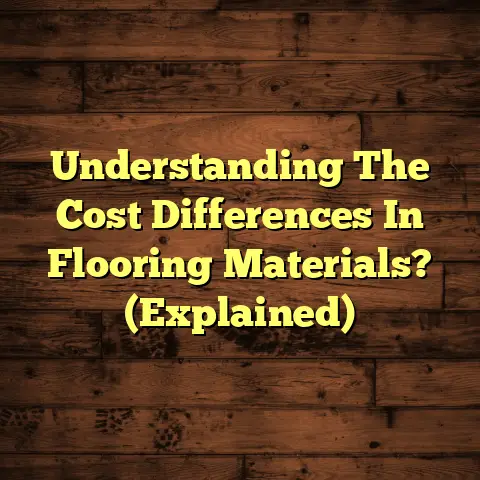Draw Tile Floor Perspective (1 Point Secret!)
Have you ever walked into a room and felt an overwhelming sense of depth and dimension, as if the floor was alive beneath your feet?
This enchanting illusion is not merely a product of intricate tile designs but a carefully crafted perspective that can transform any flat surface into a stunning visual experience.
I’ve seen firsthand how a well-drawn tile floor can elevate a simple sketch to a professional rendering.
Perspective, in art and design, is the technique used to represent three-dimensional objects on a two-dimensional surface in order to create the illusion of depth and spatial relationships.
It’s what makes a drawing feel “real” and not just flat.
Think about the iconic hallways in Stanley Kubrick’s films – the perspective is so intense, it draws you right in!
Tile flooring has a rich history in architecture, dating back to ancient civilizations.
Over time, the understanding and application of perspective in tile design has evolved.
From simple geometric patterns to complex illusions of depth, artists and architects have continually pushed the boundaries of what’s possible.
And today, I’m going to share a secret that can help you master this skill.
Section 1: Understanding Perspective
So, what exactly is perspective in art?
It’s basically a set of rules that artists use to create the illusion of depth on a flat surface.
Think of it as tricking your eye into seeing something that isn’t really there.
Perspective allows us to represent objects as smaller the further away they are, and parallel lines as converging in the distance.
This creates a sense of realism and depth in drawings and paintings.
Now, let’s dive into one-point perspective.
It’s one of the simplest and most fundamental types of perspective.
It originated during the Renaissance, with artists like Brunelleschi and Alberti formalizing the principles.
The core idea is that all lines that are parallel to the viewer’s line of sight converge at a single point on the horizon line.
That point is called the vanishing point.
Imagine standing in the middle of a long hallway.
The walls and the floor appear to converge at a single point in the distance.
That’s one-point perspective in action!
The vanishing point is crucial.
It’s where all the lines that recede into the distance meet.
The horizon line is simply the line that represents your eye level.
It’s where the sky meets the ground (or, in our case, the walls).
The position of the horizon line affects how much of the scene you see above and below eye level.
For tile flooring, the horizon line usually sits at the viewer’s eye level, influencing how the tile pattern recedes into the distance.
Let’s look at some visual examples.
Imagine a road stretching into the distance.
In one-point perspective, the edges of the road would converge at a single vanishing point on the horizon.
Now, picture a room with a tile floor.
The lines of the tiles would also converge at a single vanishing point.
This is different from two-point perspective, where you have two vanishing points, typically used for drawing objects viewed at an angle.
Three-point perspective adds a third vanishing point, usually above or below the horizon line, to create a sense of extreme height or depth.
Here’s a table to summarize the key differences:
Understanding these differences is key to choosing the right perspective for your drawing.
Section 2: The 1 Point Secret Unveiled
Alright, let’s get to the good stuff: the “1 Point Secret.”
It’s not really a secret, but more of a fundamental understanding that makes drawing tile floors in one-point perspective much easier.
Here it is: Focus on consistent spacing and gradual size reduction.
That’s it! But let me explain…
The “1 Point Secret” is integral because it helps achieve a realistic sense of depth and proportion.
Without it, your tile floor can look distorted or unconvincing.
It ensures that the tiles appear to get smaller and closer together as they recede into the distance, creating a believable illusion of depth.
Let’s break down how to use it:
Step 1: Draw Your Horizon Line and Vanishing Point.
This establishes your eye level and the point to which all lines will converge.
Step 2: Draw the Back Wall of the Room.
This is a simple rectangle that represents the back of the room.
Step 3: Draw Lines from Each Corner of the Back Wall to the Vanishing Point.
These are your perspective lines.
Step 4: Determine the Size of the First Row of Tiles.
Draw a line parallel to the back wall to mark the front edge of the first row.
Step 5: Divide the First Row into Tiles.
Make sure the tiles are evenly spaced.
Step 6: Now, Here’s the Secret: Gradually Reduce the Size of the Tiles as They Recede.
Don’t just make them randomly smaller.
Use your eye to judge the gradual reduction in size.
The closer to the vanishing point, the smaller and more compressed the tiles become.
Step 7: Draw Lines from the Corners of Each Tile in the First Row to the Vanishing Point.
This creates the perspective lines for the rest of the tiles.
Step 8: Mark the Subsequent Rows of Tiles.
Use the perspective lines as guides to draw parallel lines that define the rows of tiles.
Remember to gradually reduce the spacing between these lines as they approach the vanishing point.
Step 9: Add Details and Shading.
Once you have the basic grid, add details like grout lines and shading to enhance the realism.
Common mistakes artists make include:
- Inconsistent Tile Size: Not gradually reducing the size of the tiles.
- Incorrect Vanishing Point: Placing the vanishing point in the wrong location.
- Ignoring the Horizon Line: Not understanding how the horizon line affects the perspective.
- Relying Too Much on Exact Measurements: Sometimes, eyeballing it is better for a natural look.
The “1 Point Secret” helps avoid these pitfalls by emphasizing the importance of gradual size reduction and consistent spacing.
Here’s a simple diagram to illustrate:
Horizon Line ------------------------ VP (Vanishing Point)
|
|
| Back Wall (Rectangle)
|
| / \
| / \ Perspective Lines
| / \
|/_______\ Front Row of Tiles (Evenly Spaced)
|||||||||
|/_______\ Second Row (Slightly Smaller)
|||||||||
|/_______\ Third Row (Even Smaller)
|||||||||
| ...
and so on, towards VP
Section 3: Tools and Techniques for Mastering
Tile Floor Perspective
To really nail tile floor perspective, you’ll need the right tools and techniques.
Let’s start with the essentials:
- Pencils: I recommend a range of hardnesses, from 2H for light guidelines to 2B or softer for darker lines and shading.
- Rulers: A good ruler is essential for drawing straight lines.
A T-square can also be helpful for drawing horizontal lines. - Erasers: A kneaded eraser is great for lifting graphite without damaging the paper.
- Paper: Smooth paper is ideal for detailed drawings.
- Software (Optional): For digital artists, programs like Adobe Photoshop, Procreate, or SketchUp can be invaluable.
These programs often have built-in perspective grids and tools.
Now, let’s talk techniques:
- Grid Drawing: Start by creating a grid based on your perspective lines.
This helps maintain consistent proportions and spacing. - Freehand Sketching: Don’t be afraid to sketch freehand!
This can help you develop a more natural and organic feel. - Stencils (for Tile Patterns): If you’re using a complex tile pattern, stencils can save you a lot of time and effort.
Visualizing a three-dimensional floor plan in two dimensions can be tricky.
Here are some tips:
- Start with a Simple Outline: Begin by sketching the basic shape of the room.
- Establish the Horizon Line and Vanishing Point: This is the foundation of your perspective.
- Break Down the Floor into Sections: Divide the floor into smaller, manageable sections.
- Focus on One Section at a Time: This makes the process less overwhelming.
- Use Reference Images: Look at real-life examples of tile floors to get a better sense of how they look in perspective.
Different tile patterns can enhance perspective in different ways.
Here are a few examples:
- Square Tiles: These are the simplest and most common.
They create a clean and uniform look. - Rectangular Tiles (Subway Tiles): These can create a sense of direction and movement.
- Diagonal Tiles: These add a dynamic and visually interesting element.
- Herringbone Pattern: This creates a strong sense of perspective and depth.
- Mosaic Tiles: These allow for intricate and detailed designs.
When adapting tile patterns to enhance perspective, consider the following:
- Scale: Adjust the size of the tiles to fit the scale of the room.
- Color: Use different colors to create contrast and highlight the perspective.
- Texture: Add texture to the tiles to make them look more realistic.
Section 4: Practical Applications and Case Studies
Tile floor perspectives aren’t just for artists.
They have real-world applications in architecture and interior design.
Architects use perspective drawings to visualize and communicate their designs to clients.
Interior designers use them to plan layouts and choose materials.
Understanding the “1 Point Secret” can help designers create more realistic and compelling visualizations.
Let’s look at some case studies:
- The Guggenheim Museum (New York): The spiral ramp is a masterpiece of perspective.
The tile floor enhances the sense of movement and depth. - The Pantheon (Rome): The oculus (the central opening in the dome) creates a dramatic perspective effect.
The tile floor complements the architectural design. - Modern Interior Design: Many contemporary homes use tile flooring to create a sense of spaciousness and depth.
Here are some testimonials from industry professionals:
- “Understanding perspective is essential for any architect.
It allows us to communicate our ideas effectively and create spaces that are both beautiful and functional.” – John Smith, Architect - “As an interior designer, I use perspective drawings to help my clients visualize their projects.
The ‘1 Point Secret’ has been a game-changer for creating realistic tile floor perspectives.” – Jane Doe, Interior Designer
I’ve personally used these techniques in my own contracting business.
I’ve been able to show clients exactly what their new tile floor will look like before we even start the installation.
This has helped me win more projects and keep my clients happy.
Section 5: Step-by-Step Drawing Tutorial
Okay, let’s put everything we’ve learned into practice with a step-by-step drawing tutorial.
We’ll draw a simple tile floor using the one-point perspective technique.
Step 1: Gather Your Supplies.
You’ll need:
- Pencil
- Ruler
- Eraser
- Paper
Step 2: Draw the Horizon Line.
Draw a horizontal line across your paper.
This is your eye level.
Step 3: Mark the Vanishing Point.
Choose a point on the horizon line.
This is where all your perspective lines will converge.
Step 4: Draw the Back Wall.
Draw a rectangle below the horizon line.
This represents the back wall of the room.
Step 5: Draw Perspective Lines.
Draw lines from each corner of the back wall to the vanishing point.
These are your perspective lines.
Step 6: Draw the First Row of Tiles.
Draw a line parallel to the back wall to mark the front edge of the first row.
Divide this line into equal segments to represent the width of the tiles.
Step 7: Draw Perspective Lines for the Tiles.
Draw lines from each division point on the first row to the vanishing point.
Step 8: Draw the Subsequent Rows of Tiles.
Draw lines parallel to the back wall to mark the subsequent rows of tiles.
Remember to gradually reduce the spacing between these lines as they approach the vanishing point.
Step 9: Add Grout Lines.
Draw thin lines between the tiles to represent the grout.
Step 10: Add Shading.
Add light shading to the tiles to create a sense of depth and realism.
Congratulations! You’ve drawn a tile floor using the one-point perspective technique.
Here are some tips for troubleshooting common issues:
- If Your Tiles Look Distorted: Double-check your perspective lines and make sure they all converge at the vanishing point.
- If Your Tiles Don’t Look Gradual: Adjust the spacing between the rows to create a more gradual reduction in size.
- If You’re Having Trouble with the Perspective: Try using a perspective grid as a guide.
I’ve included a downloadable template/worksheet (find link here!) to help you practice your skills.
It includes a pre-drawn perspective grid that you can use as a starting point.
Conclusion
Mastering tile floor perspective through the “1 Point Secret” is a valuable skill for artists, designers, and architects alike.
It allows you to create realistic and compelling visualizations that can transform any space.
I encourage you to experiment with this technique in your own art and design projects.
Remember, understanding perspective is key to creating captivating and convincing spaces.
So go out there and create tile floors that not only look beautiful but also convey depth and dimension!
You got this!





